Laryngeal Videostroboscopy
Visiting a laryngologist (voice doctor), or voice specialist, can be a slightly different experience than seeing a general Ear, Nose, and Throat surgeon. Once your physician has referred you to the Chicago Institute for Voice Care for assessment, you will likely undergo a laryngeal videostroboscopic examination. This procedure enables the doctor to assess not only the general appearance of the vocal cords (folds), but also the vibratory characteristics of the vocal cords while you make sound. Since how the vocal cords vibrate determines what voice comes out, this is an essential step in determining the cause of hoarseness.

There are two main approaches to seeing the vocal cords in the office.
- A small camera is attached to the end of a rigid endoscope and will be placed in your mouth to look over the back of your tongue onto the vocal cords (folds). This approach feels a lot like having a doctor use the large popsicle stick to see the tonsils, but we can see a bit further.
- An even smaller camera is in a flexible scope that can pass through the nose and down to the vocal cords. This camera resembles a thick piece of spaghetti but has a powerful, digital camera at the end.
Once the vocal cords are visualized, the process is the same. Because the vocal cords vibrate so rapidly, a strobe light is utilized make a slow motion representation of the vibrating vocal folds. We will usually record and save this file for reference and review. You will be able to see the video at the end of the examination if you like. By watching the vocal fold vibration, the examiner is able to check for stiffness, irregularity of movement, inappropriate closure, and other disorders related to the motion of the vocal folds that cannot be seen well without the use of the strobe light.
Both approaches are minimally-invasive, painless technologies that provide your healthcare professional with outstanding views of the larynx and the vibrating vocal cords. The difference between the rigid and flexible scopes is often a matter of patient preference.
No particular preparation is required for either exam, though often, we will use a decongestant and possibly topical anesthesia to make the approach more comfortable.